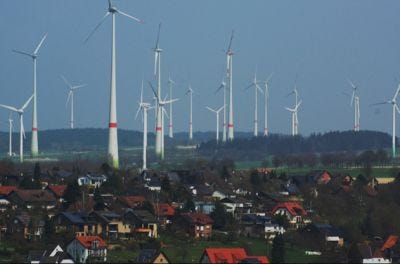Coal Exports to Europe – A Photo Essay
When it comes to energy policies, Germany has been committing slow, ritual suicide. And, yet, its carbon footprint increases while that of the United States has declined. What gives?
I got out for a run early Sunday morning so that I might beat the heat. A train rumbled overhead as I ran under the trestle. That train looked much like the one pictured here on that same track: a mile-long train of open cars brimming with coal.
That coal was likely originating in West Virginia and was going east to a shipping terminal at Newport News, Virginia. This one:
That coal, in turn, will likely end up in this stash of coal at a shipping terminal in Rotterdam (The Netherlands):
Or on the Elbe River in Hamburg, Germany:
Either way, that coal will end up doing what’s it’s been doing since Germany turned to its suicidal energy policies: Fueling industry, summer cooling, and winter heating when the wind is not driving those wind turbines or the sun is not animating those fields of solar panels:
Who wouldn’t want to live in this charming house, with satellite TV and all?:
Meanwhile, on February 13 of this year, a week-and-a-half before the Russians invaded Ukraine, France24 could report that “Germany loses patience with ex-chancellor's Russia lobbying.” That ex-chancellor would be Gerhard Schröder. Schröder served as chancellor from 1998 through 2005. He then joined Nord Stream AG, a consortium dedicated to building a pipeline that would deliver natural gas from Vyborg, Russia to Greifswald, Germany. In April of this year, Schröder joined the board of directors of Gazprom, the Russian entity that supplies that gas.
I would be willing to suggest that there is nothing wrong with building pipelines per se, but it was obvious to some observers back in 2005 that Germany might make itself hostage to Gazprom, an entity in which the Russian government owns a majority stake. What could go wrong?
The Energy Information Administration, a US government agency, does not yet provide data on American coal exports in 2022, but its monthly reports through 2021 do illuminate interesting features of coal and gas markets. Consider the following graph that I nabbed from https://www.eia.gov/energyexplained/coal/imports-and-exports.php:
The blue line indicates total, annual coal production in the United States (in “millions of short tons”) from 1950 through 2021. The brown line indicates coal consumption. Consumption peaked in 2008, and production peaked in 2009. This had nothing to do with “green” policies. It had everything to do with the fracking revolution. Natural gas was becoming so inexpensive that energy producers decided to convert coal-fired electricity generation capacity to gas.
Before the fracking revolution, coal-fired generation and nuclear generation had served “baseload” demands for energy. Natural gas facilities were generally relegated to serving peak demands such as the demands for energy that come on a hot day when everyone turns on the air-conditioning. A gas-fired electricity generator had been (and still is) basically a jet-engine bolted to the ground. Indeed, gas-fired generators are manufactured by much the same people, such as Siemens (a German family of companies) and Rolls-Royce, who produce jet engines. Like jet engines, gas-fired generators are easy to fire up on short notice, and they are easy to turn down. In contrast, coal-fired facilities and nuclear require more time to “ramp up” and turn down, and such facilities had generated electricity at the lowest cost per unit (megawatt-hour). The optimal program had been to turn such facilities on and to let them run continuously, shutting them down only to accommodate maintenance. The utilities would use the gas-fired facilities to accommodate the ups and downs in demands for energy.
The sustained and sustainable decline in gas prices changed all that. Gas-fired facilities now serve much of the baseload. An added benefit is that gas-fired generation yields much less particulate matter and—dare I say it—less carbon dioxide than coal-fired generation. That is why the carbon footprint of the United States has declined both absolutely and as a proportion of each dollar of GDP. Not so in Germany and Europe as a whole. American pro-energy policies have proven to be far greener than explicitly green policies in Western Europe. Ironic.
Meanwhile, we are hearing that coal exports to Europe are picking up in 2022. The EIA data do not yet afford visibility in to this phenomenon, but the EIA does report, country by country, where coal exports had gone in 2021. See, for example, https://www.eia.gov/coal/production/quarterly/pdf/t7p01p1.pdf. But, here is a high-level view:
South Korea may be very ostentatiously all-in on green energy, but it ranks among the top-five importers of American coal, importing about half of what China has imported. That shipping facility in Rotterdam must also be busy processing American coal for European consumption.
Germany also shows up prominently in the EIA data, but one has to wonder how much of that coal going to Rotterdam ends up in Germany or Poland or elsewhere. The bigger point, however, is:
When it comes to energy policies, Germany has been committed to slow, ritual suicide at the altar of the gods of climate change. It has committed to solar energy in the cloudy climes of Northern Europe. After the Fukushima incident in Japan, Germany shut down its nukes. Well before that, Germany had made itself hostage to Gazprom, the state-controlled Russian gas supplier. Again, what could go wrong? Germany is now committed to re-engaging coal-fired generation capacity.
Under the leadership of the Biden Administration, the United States seems intent on following Germany’s lead by committing to its own slow, ritual suicide. One might object to this characterization, however, Because Climate Change. More on that another time, but note again that energy production in the United States had been getting cleaner and less carbon-intensive without government intervention. That is also a topic to further develop in successive essays.
Meanwhile, Bloomberg News tells us that “Wind Turbine Blades Can’t be Recycled”: https://www.bloomberg.com/news/features/2020-02-05/wind-turbine-blades-can-t-be-recycled-so-they-re-piling-up-in-landfills
And “Solar Panels Produce Tons of Toxic Waste”: https://www.americanexperiment.org/solar-panels-produce-tons-of-toxic-waste-literally/
Once one gets beyond the hype, one can see that “It’s Not Easy Being Green,” afterall.











So not only is America's carbon footprint lower than countries with explicitly "green" energy polices, but we owe it all to fracking?
Ironies piling atop ironies.
Spot on! The ESG reduction in investments some four years ago have arrived just in time to spur a recession. Who knew CoV would arrive back then to remove supplies? Sadly, the greenies weren't happy with slow progress, they wanted all EVs now as if it were possible like an Amazon delivery. As if it is realistic to imagine battery EVs ever arriving in the necessary numbers. That power required for those EVs requires considerable investment that won't be possible for a long time. But arriving in power as they have, they are stuck in those past years. Sorry much has changed.
At least we don't HAVE to be as foolish as Germany or Spain. We likely will not suffer the likes of a incompetent Biden administration again, but who knows what tricks lie ahead.